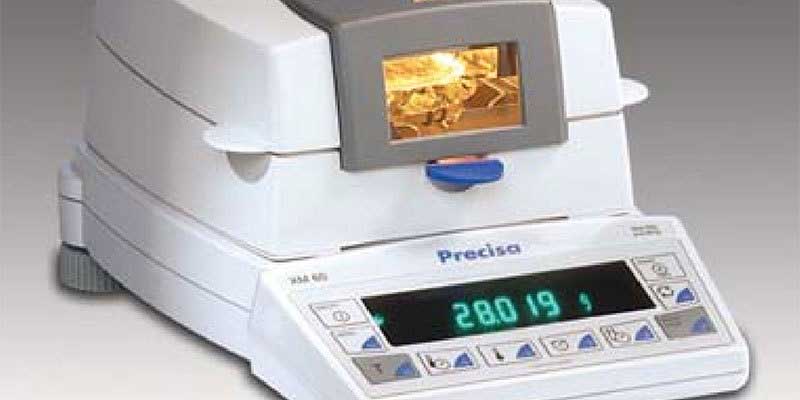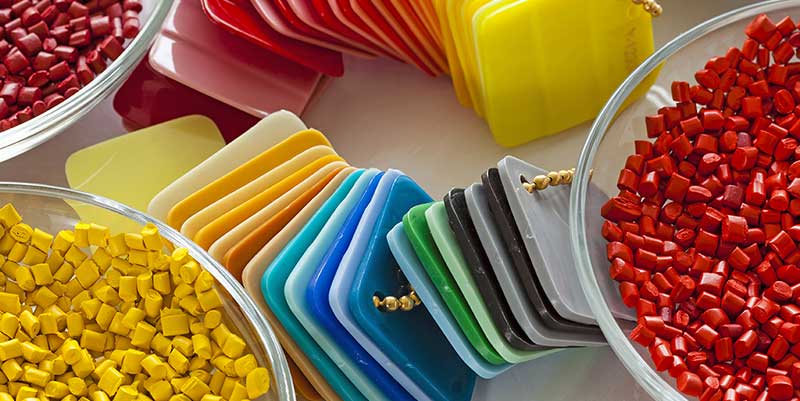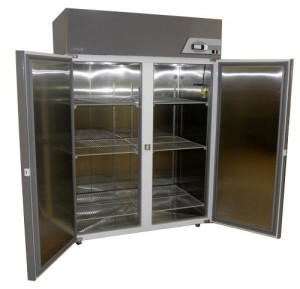Moisture Balance
How to Determine Moisture Content
Moisture content – the amount of moisture contained in a product – can be determined by using a moisture analyzer. Specifications for correct moisture content span a host of industries and products. Here you will learn how moisture analyzers are employed by researchers, QC personnel, professional associations, and government agencies to ensure products meet moisture content specs. It includes info on how moisture analyzers work along with purchasing and operating tips.
Why Moisture Content is Critical
According to Title 21 of the Code of Federal Regulations section n, “Safe-moisture level is a level of moisture low enough to prevent the growth of undesirable microorganisms in the finished product under the intended conditions of manufacturing, storage, and distribution.”
Types of Moisture
While most folks think of moisture as water, moisture is anything that evaporates on heating. Examples include fats, oils, alcohol, and solvents.
Moreover, moisture can lurk in places you … Read the rest
Moisture Balance Ideal for QC in Molding Plastics
Operators of extrusion molding, injection molding, thermoforming and related equipment must pay particular attention to resin moisture content because too much or too little moisture will impact the quality of molded products. Correct moisture content depends on the resins being used and is specified by plastic resin manufacturers.
Resin manufacturers may ship product at the correct moisture content but equipment operators should take steps to ensure ambient conditions at the plant do not raise or lower the content prior to processing. Two important steps in quality control are proper resin storage and using commercial drying ovens. Periodic checks with a benchtop moisture analyzer programmed for plastic resins provide assurances that moisture content is on target, or otherwise call for pre-processing adjustments.
The Benchtop DSC 71P Lab Moisture Analyzer for Quality Control
Operating on the LOD (loss of weight on drying) process it handles samples to 71 grams and delivers … Read the rest
Moisture Analyzer for Plastic Resins
When you select a moisture analyzer for low-moisture plastic resins you will need a model that that not only can quickly but also accurately gauge the moisture content of these resins. And as with many quality control requirements that involve moisture content, you’ll want a moisture balance that can meet standards set by trade associations and professional organizations.
In this post you’ll get a briefing on the following:
- why low moisture content is important in plastic resins
- a technical standard that applies to determining moisture in plastics
- how benchtop moisture analyzers work
- a standards-compliant moisture analyzer
for plastic resins
Why Low Moisture Content is Important
Owners of injection molding companies and operators of injection molding machines are aware that incorrect moisture content in plastic resins can result in an inferior finished product.
Product shipped from resin suppliers may have the specified moisture content but ambient conditions … Read the rest
Stability Testing for Temperature and Humidity
Stability Testing for Temperature and Humidity
Stability testing is a critical part of drug and medicinal product development to determine the shelf life of such products under a variety of environmental conditions such as temperature and humidity. Family prescriptions likely have on their label a recommended “use by” date and notification if special storage conditions should be observed. The regulatory mandate for stability testing in the United States is contained in 21 CFR Part 211 Section 166.
Tests to determine storage requirements and shelf life for drugs and other medicinal products are taken under a variety of imposed and tightly controlled environmental conditions. Because testing time can be extensive accelerated studies are permitted to support tentative expiration dates provided full shelf life studies are being conducted.
Temperature and Humidity Test Chamber Specs
Stability testing is performed in specially designed test chambers capable of duplicating a broad range of temperature … Read the rest
Environmental Test Chamber Series with Ultrasonic Humidifiers
A new series of environmental test chambers now available from Tovatech in 4 storage capacities from 24 to 80 cubic feet feature ultrasonic humidifiers producing far smaller water particles than centrifugal humidifiers. The ultrasonic humidifiers are placed above rather than inside storage cabinets thereby freeing space for additional test specimens. Dehumidification is handled by a separate latent coil. Both systems are operated by a programmable logic microprocessor controller.
The ultrasonic humidifiers require water with low mineral content delivered at 10 to 60 psi. As a means of conserving this water an optional purification system for tap water is available. Connected to the temperature humidity stability test chamber it continuously recycles used water drawn from the unit’s pluggable interior drain.
The system delivers a humidity variation of ±3% in the humidity controlled temperature range between 10⁰ and 70⁰C.
Precise temperature control at ± … Read the rest
A Moisture Analyzer for Shampoo Quality Control
Most everyone has their favorite shampoo and probably pays little attention to what’s inside the tube or bottle – only that it does a good job cleaning hair. Chances are the thickness of the shampoo is important as well – cheaper brands that are thin and watery usually don’t pass muster. Yet water, specifically deionized water – comprises about 70 to 80% of the shampoo formulation with the actual target specified by the manufacturer. Keeping formulations on target is eased with a moisture analyzer for shampoo quality control.
While formulations vary, the approximately 25% non-water contents of shampoo include detergents and surfactants, foam boosters, thickeners and conditioners. Preservatives and modifiers, fragrances and dyes are typically added to the batch then mixed. After the mixing period samples are sent to the quality control lab. Among other tests QC personnel can use a moisture analyzer to determine that the water content is … Read the rest
Selecting a Moisture Analyzer Drying Process
Infrared moisture analyzers such as the new Kern MLS-C now available from Tovatech use the thermogravimetric drying process to calculate the moisture content of a sample. Also called the loss of weight on drying (LOD) method, the drying process compares the weight of a sample after drying to the weight before drying. The difference is displayed the percent of moisture in the sample. This is a critical quality control step to confirm that commercial bulk drying ovens are performing to specification and that the product meets regulatory or industry standards for moisture content.
Selecting the Moisture Balance Drying Mode
Because products react differently to heat employed during the drying process, laboratory moisture balances can be programmed for different drying modes or drying profiles. These can be classified as standard, rapid, step and gentle. The mode is graphically displayed on the control panel. Here is a general description of each:
- Standard
How to Use a Moisture Analyzer for Dry Bulk Powders
The moisture content of virtually any product on the market has a bearing on the product’s quality, shelf life and a host of other considerations. Ideal moisture content varies, of course, with the product under consideration. Ideal moisture content is determined by and in some cases governed by industry associations and regulatory authorities. Proof of compliance is eased when a moisture analyzer is employed on a regular basis as batches are prepared for packaging, whatever the product, and records are kept.
Moisture analyzers such as the Kern models offered by Tovatech operate on the thermogravimetric principle using halogen heaters in combination with an analytical balance to precisely determine the percentage of moisture in a sample during a programmed testing cycle. Simply stated the sample is weighed before moisture analysis begins, and after the cycle is completed. The loss in weight is the moisture content.
Let’s Take Cement as an Example… Read the rest




